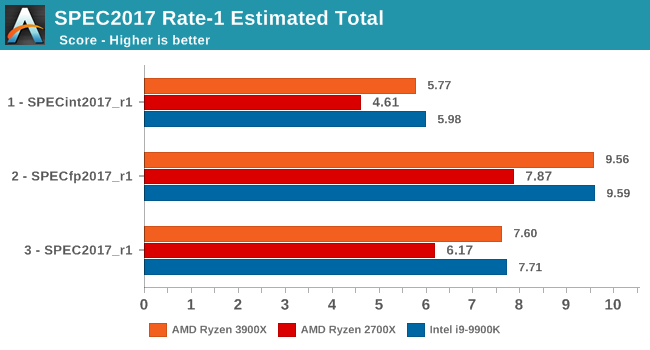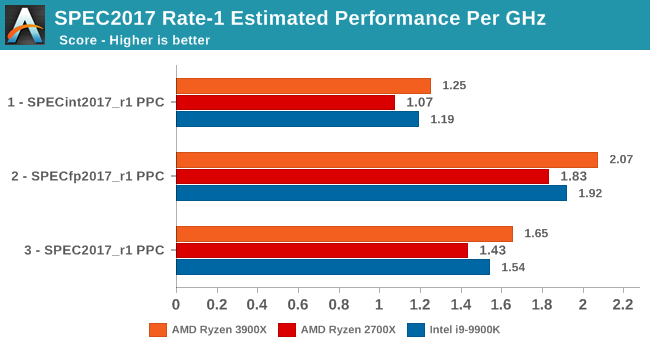The AMD 3rd Gen Ryzen Deep Dive Review: 3700X and 3900X Raising The Bar
by Andrei Frumusanu & Gavin Bonshor on July 7, 2019 9:00 AM ESTSPEC2006 & 2017: Industry Standard - ST Performance
One big talking point around the new Ryzen 3000 series is the new augmented single-threaded performance of the new Zen 2 core. In order to investigate the topic in a more controlled manner with better documented workloads, we’ve fallen back to the industry standard SPEC benchmark suite.
We’ll be investigating the previous generation SPEC CPU2006 test suite giving us some better context to past platforms, as well as introducing the new SPEC CPU2017 suite. We have to note that SPEC2006 has been deprecated in favour of 2017, and we must also mention that the scores posted today are noted as estimates as they’re not officially submitted to the SPEC organisation.
For SPEC2006, we’re still using the same setup as on our mobile suite, meaning all the C/C++ benchmarks, while for SPEC2017 I’ve also went ahead and prepared all the Fortran tests for a near complete suite for desktop systems. I say near complete as due to time constraints we’re running the suite via WSL on Windows. I’ve checked that there are no noticeable performance differences to native Linux (we’re also compiling statically), however one bug on WSL is that it has a fixed stack size so we’ll be missing 521.wrf_r from the SPECfp2017 collection.
In terms of compilers, I’ve opted to use LLVM both for C/C++ and Fortran tests. For Fortran, we’re using the Flang compiler. The rationale of using LLVM over GCC is better cross-platform comparisons to platforms that have only have LLVM support and future articles where we’ll investigate this aspect more. We’re not considering closed-sourced compilers such as MSVC or ICC.
clang version 8.0.0-svn350067-1~exp1+0~20181226174230.701~1.gbp6019f2 (trunk) clang version 7.0.1 (ssh://git@github.com/flang-compiler/flang-driver.git 24bd54da5c41af04838bbe7b68f830840d47fc03) -Ofast -fomit-frame-pointer -march=x86-64 -mtune=core-avx2 -mfma -mavx -mavx2
Our compiler flags are straightforward, with basic –Ofast and relevant ISA switches to allow for AVX2 instructions.
The Ryzen 3900X system was run in the same way as the rest of our article with DDR4-3200CL16, same as with the i9-9900K, whilst the Ryzen 2700X had DDR-2933 with similar CL16 16-16-16-38 timings.

In terms of the int2006 benchmarks, the improvements of the new Zen2 based Ryzen 3900X is quite even across the board when compared to the Zen+ based Ryzen 2700X. We do note however somewhat larger performance increases in 403.gcc and 483.xalancbmk – it’s not immediately clear as to why as the benchmarks don’t have one particular characteristic that would fit Zen2’s design improvements, however I suspect it’s linked to the larger L3 cache.
445.gobmk in particular is a branch-heavy workload, and the 35% increase in performance here would be better explained by Zen2’s new additional TAGE branch predictor which is able to reduce overall branch misses.
It’s also interesting that although Ryzen3900X posted worse memory latency results than the 2700X, it’s still able to outperform the latter in memory sensitive workloads such as 429.mcf, although the increases for 471.omnetpp is amongst the smallest in the suite.
However we still see that AMD has an overall larger disadvantage to Intel in these memory sensitive tests, as the 9900K has large advantages in 429.mcf, and posting a large lead in the very memory bandwidth intensive 462.libquantum, the two tests that put the most pressure on the caches and memory subsystem.

In the fp2006 benchmarks, we gain see some larger jumps on the part of the Ryzen 3900X, particularly in 482.sphinx3. These two tests along with 450.soplex are characterized by higher data cache misses, so Zen2’s 16MB L3 cache should definitely be part of the reason we see such larger jumps.
I found it interesting that we’re not seeing much improvements in 470.lbm even though this is a test that is data store heavy, so I would have expected Zen2’s additional store AGU to greatly benefit this workload. There must be some higher level memory limitations which is bottlenecking the test.
453.povray isn’t data heavy nor branch heavy, as it’s one of the more simple workloads in the suite. Here it’s mostly up to the execution backend throughput and the ability of the front-end to feed it fast enough that are the bottlenecks. So while the Ryzen 3900X provides a big boost over the 2700X, it’s still largely lagging behind the 9900K, a characteristic we’re also seeing in the similar execution bottlenecked 456.hmmer of the integer suite.

Overall, the 3900X is 25% faster in the integer and floating point tests of the SPEC2006 suite, which corresponds to an 17% IPC increase, above AMD's officially published figures for IPC increases.
Moving on to the 2017 suite, we have to clarify that we’re using the Rate benchmark variations. The 2017 suite’s speed and rate benchmarks differ from each other in terms of workloads. The speed tests were designed for single-threaded testing and have large memory demands of up to 11GB, while the rate tests were meant for multi-process tests. We’re using the rate variations of the benchmarks because we don’t see any large differentiation between the two variations in terms of their characterisation and thus the performance scaling between the both should be extremely similar. On top of that, the rate benchmarks take up to 5x less time (+1 hour vs +6 hours), and we're able run them on more memory limited platforms (which we plan on to do in the future).

In the int2017 suite, we’re seeing similar performance differences and improvements, although this time around there’s a few workloads that are a bit more limited in terms of their performance boosts on the new Ryzen 3900X.
Unfortunately I’m not quite as familiar with the exact characteristics of these tests as I am with the 2006 suite, so a more detailed analysis should follow in the next few months as we delve deeper into microarchitectural counters.

In the fp2017 suite, things are also quite even. Interesting enough here in particular AMD is able to leapfrog Intel’s 9900K in a lot more workloads, sometimes winning in terms of absolute performance and sometimes losing.

As for the overall performance scores, the new Ryzen 3900X improves by 23% over the 2700X. Although closing the gap greatly and completely, it’s just a hair's width shy of actually beating the 9900K’s absolute single-threaded performance.

Normalising the scores for frequency, we see that AMD has achieved something that the company hasn’t been able to claim in over 15 years: It has beat Intel in terms of overall IPC. Overall here, the IPC improvements over Zen+ are 15%, which is a bit lower than the 17% figure for SPEC2006.
We already know about Intel’s new upcoming Sunny Cove microarchitecture which should undoubtedly be able to regain the IPC crown with relative ease, but the question for Intel is if they’ll be able to still maintain the single-thread absolute performance crown and continue to see 5GHz or similar clock speeds with the new core design.










447 Comments
View All Comments
Ninjawithagun - Monday, July 8, 2019 - link
Originally, I was going to wait for Zen 3, but I think I can consider buying a 3700X to 'get me by' until next year. No way am I buying a new X570 motherboard. Replaceing my 2700X with the 3700X is good enough until Zen 3 and new AM5 socket and new X670(?) chipset are released next year. Of course, the chipset name is hypothetical, so it's my best guess as to what AMD will call next year's new hardware ;-)Ninjawithagun - Monday, July 8, 2019 - link
*Replacinghaukionkannel - Tuesday, July 9, 2019 - link
Am4 next year. Am5 two years from now...Korguz - Tuesday, July 9, 2019 - link
um.. we have AM4 now....AntonErtl - Monday, July 8, 2019 - link
Thanks for the review.Two things I would like to see (maybe in an update): ECC support (I expect that it's like for Ryzen 1XXX: unsupported, but works with Asrock and ASUS boards) and RAM capacity: Can you use 4 of Samsung's 32GB DIMMs for 128GB RAM?
The Average - Monday, July 8, 2019 - link
This x570 motherboard states that it supports ECC so maybe it is indeed up to the motherboard vendors to support it.https://www.amazon.com/ASUS-Pro-WS-Workstation-Mot...
phoenix_rizzen - Tuesday, July 9, 2019 - link
ECC is supported in all Ryzen CPUs as it's part of the built-in memory controller. However, it's up to the motherboard makers to enable support for it in the RAM slots and BIOS and whatnot.If a motherboard claims support for Ryzen Pro, I believe that's a good indication it supports ECC. Otherwise, you have to dig around in the motherboard manual to find out.
UberHamburgler - Monday, July 8, 2019 - link
This is quite impressive, as AMD engineers hinted last year in leaks that they feared Zen 2 would be server and mobile only design. TSMC's first generation 7nm process is heavily optimized for efficiency and they didn't expect it to scale well past 3.5 GHz. Intel better have its 10nm process in full swing by the end of the year, otherwise they're in for a beating when Rome and the mobile variant launch - it's no secret that chip manufacturers only care about desktop to the extent that they win good press from enthusiasts.On a side note. What are the potential gains from kernel optimizaions similar to what happened a few months after the original Ryzen, this seems to be a similar restructuring of the cache.
Irata - Monday, July 8, 2019 - link
Cudos to you guys for re-running the benches.It's kinda sad that that AMD's releases seem like a "beta fest". While the products themselves are pretty good, issues with Bios or drivers often seem to be a let down.
It must stink to put in all the work to bench a system just to have to re-do it again.
Still, seeing how the results are already pretty good, I am hopeful that they will improve further after updates / patches.
poohbear - Monday, July 8, 2019 - link
Why are the gaming benchmarks at only 720p and 1080p? Is this what most people game at these days? Most gaming benchmarks are 1080, 1440 and 4k. Oh the CPU doesn't have much affect above 1080 you say? Well good, PLEASE SHOW THAT. People need to know this when making CPU decisions. If AMD trounces Intel at everything office related, and @ 1440 & 4k there is no difference, then that will absolutely affect my buying decision. Why are you showing 720p when hardly anyone games at that rez?